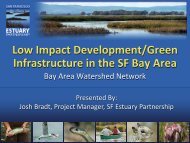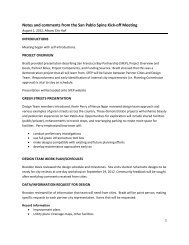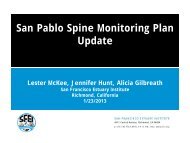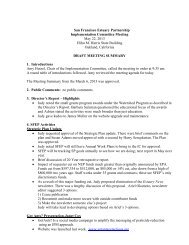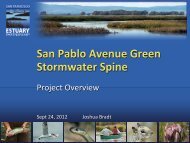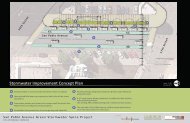Estuary News, June 2013 PDF - San Francisco Estuary Partnership
Estuary News, June 2013 PDF - San Francisco Estuary Partnership
Estuary News, June 2013 PDF - San Francisco Estuary Partnership
Create successful ePaper yourself
Turn your PDF publications into a flip-book with our unique Google optimized e-Paper software.
3H Y D R O L O G YBay versus BoatsIn light of the two recent crashes,one deadly, much has been made ofthe relative safety of the new America’sCup boats on the <strong>San</strong> <strong>Francisco</strong>Bay. Are the $10 million catamarans,known by the class name AC72, simplytoo fast and too light to sail safelyunder any conditions? Or are localconditions responsible?The pattern of surface currentson the Bay is uncommonly complexdue to the narrow opening of theGolden Gate and the varied geologyand bathymetry of the inner Bay, saysUS Geological Survey coastal geologistPatrick Barnard. “It’s never reallyunidirectional if you go across thewest Central Bay,” he said. “There’salways currents going in the oppositedirection” (see graphics).These currents move swiftly — upto 2.5 meters per second at the mouthof the Bay — and change direction ona dime, making it rare to encounter“slack” water. Where opposing currentsconverge, he says, sailors canexpect choppy water and even eddies.All this is compounded by tidal shiftsand the powerful gusty winds blastingthrough the Golden Gate.However, it’s unclear how muchthese conditions impact the AC72,especially when it floats over the wateron massive hydrofoils at speedsof up to double the wind speed. JohnArndt, of the Marin-based sailingmagazine Latitude 38, says theAC72 was designed in part to suit<strong>San</strong> <strong>Francisco</strong> Bay, and that typicalconditions are unlikely to be a safetyfactor for America’s Cup sailors.However, he does acknowledge thatthe complex interaction of surfacecurrents adds to the challenge of therace. ”The current is what makes itinteresting sailing on the Bay; it addsanother level of intrigue,” he says.Local sailing expert Kimball Livingstonagrees that the Bay’s complexcurrents need to be accountedfor, but thinks that their influence onPhoto: Guilain Grenierthe AC72 is limited. “If you’re going40 mph, the tidal component is goingto be a lot less,” he says. “The boatsare so fast that it takes a very largetidal component to override otherfactors.”Ultimately, both suggested thatfinal blame for the two crashes todate may lay with the boats, eitherdue to design shortcomings or structuralflaws. “You’re not supposed tobreak a boat when you have a crash,”Livingston says of the Artemis Racingincident on May 9. “There was somethingelse that went on.” NSScientists can get a sense of flow directions and currents by tracking sediments suspended in the water. These two charts show simulations for aflood tide and the onset of an ebb tide under the Golden Gate Bridge. Note the formation of eddies immediately inside the Golden Gate on the bayside of Pt. Cavallo and Fort Point at flood tide. During the transition from flood to ebb tide (right panel) transport is complicated by the presence ofrock outcrops and deep channels that make up the seabed at the Gate. (White lines and circles show areas where measurements were obtained.)Source: Erikson, L.H., et al, USGS, as submitted for Marine Geology, Special Issue on <strong>San</strong> <strong>Francisco</strong> Bay.



